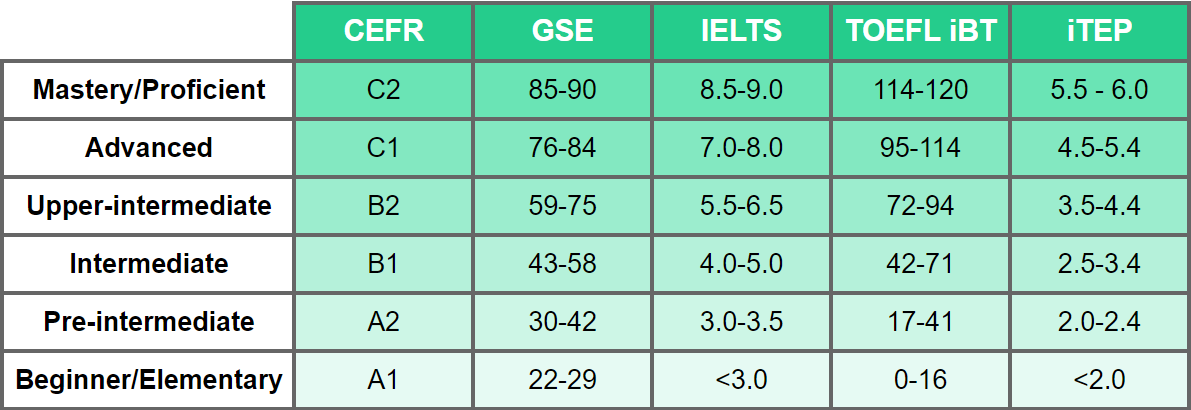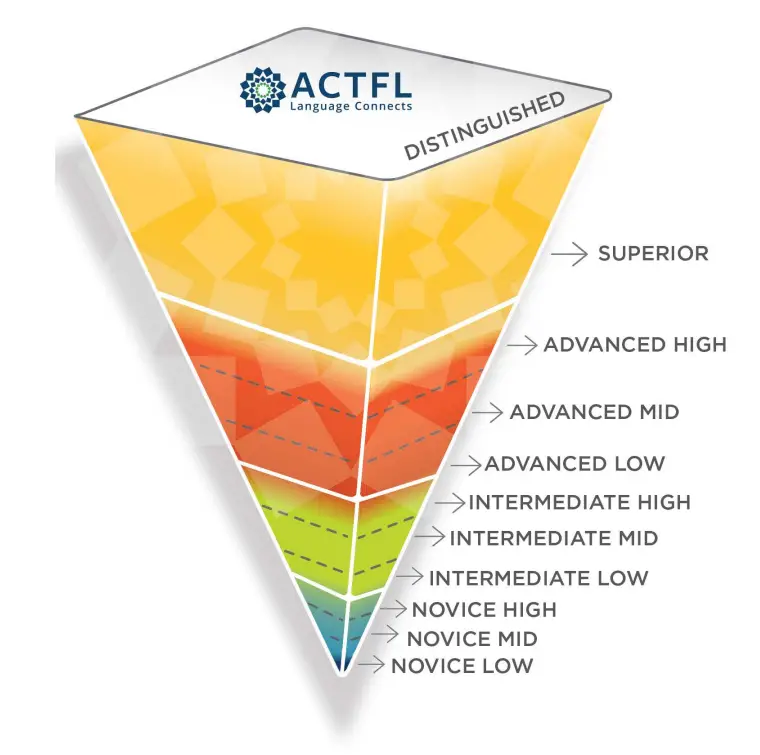Learning English can be tricky enough, but all the different ways of grading ESL levels can add an extra layer of confusion for students, teachers, assessors, and employers.
There are many different English proficiency frameworks, including:
- CEFR
- GSE
- IELTS
- TOEFL
- TOEIC
- iTEP
- ACTFL
Some of these are widely recognized international standards whereas others serve a more specific purpose. We’ll look at each of these in more detail in this article.
So, if you are trying to understand what your assessment level means, why it matters, or how one score compares to another, this guide will help clear things up.
ESL levels chart

Note: This chart is a guide to equivalent levels across different scoring systems, but due to the way each test is uniquely scored, individual results may vary.
How many ESL levels are there?
As you can see from the chart above, there are different numbers of ESL levels depending on the framework you use. The CEFR, the most widely used international language standard, has six levels (or seven, if you include pre-beginner). Other frameworks have five or six levels, and some use a points-based scale that is not divided into levels at all.
What they all have in common is that they assess English learners on key skills – including reading, writing, speaking, and listening – and produce a score that reflects their overall English proficiency.
Why do English language levels matter?
There are several reasons why it’s helpful for learners to take an English language test and know their proficiency level:
- To help students track their progress as they increase their knowledge of the language
- To set relevant English learning goals and realistic expectations
- To place learners in classes at the correct level and offer appropriate instruction
- To fulfill entry requirements for college or university
- For employers to understand a potential employee’s English abilities

Proficiency vs fluency
It’s important to differentiate between fluency and proficiency. Fluency in English is about smooth communication, while proficiency centers on accuracy in terminology, grammar, and phrasing. Both are necessary to truly master a language.
English proficiency involves being able to:
- Comprehend and use written and oral communication during real-life interactions
- Understand and use grammar and vocabulary accurately
- Read and understand different types of texts
- Engage in conversations and discussions on a wide range of topics
- Write clear and coherent texts
Your ESL level should reflect how well you can do each of these things.
The most common language proficiency frameworks
Now, we will look in greater detail at the most common language proficiency frameworks, both in the US and globally.
Take a look at the different ESL levels for each one and the type of English learner they are designed for.
CEFR (Common European Framework of Reference for Languages)
The Common European Framework of Reference for Languages (CEFR, CEF, or CEFRL) was created by the Council of Europe as a way to measure language learner proficiency. It was originally applied to European languages but has gained global acceptance and become an internationally adopted framework to describe language learning levels.
The CEFR uses a six-point scale from A1 to C2, grouped into three broad categories: Basic User (A1, A2), Independent User (B1, B2), and Proficient User (C1, C2).
Many teaching institutions that use the CEFR framework break it down further. For example, British Council and Preply define CEFR language levels as:
| CEFR Level | Description |
|---|---|
| A0/A1 | Beginner/Elementary |
| A2 | Pre-intermediate |
| B1 | Intermediate |
| B2 | Upper-Intermediate |
| C1 | Advanced |
| C2 | Mastery/Proficient |
Since this is one of the most widely used language proficiency frameworks, let’s take a detailed look at what each level means and how long it takes to learn English at each level.
CEFR Level A1 (Beginner/Elementary)
CEFR A1 level applies to Basic Users of English whose understanding of the language allows them to:
- Communicate in common, everyday situations with someone who speaks slowly and uses simple language
- Understand and use familiar expressions and very basic phrases to address specific needs
- Introduce themselves and others
- Ask and answer questions about personal details
- Talk about possessions and hobbies
Approximate number of words: 700
Average hours of study: 100
Note that some institutions add an extra level before this, usually named A0, to describe complete beginners with almost no knowledge of the language.
CEFR Level A2 (Pre-Intermediate)
Although still classed as a Basic User, learners at CEFR A2 level are starting to understand more and communicate in complete sentences. They can:
- Take part in everyday small talk on familiar topics of immediate relevance (local area, family, shopping, employment)
- Express a simple opinion
- Read and write simple texts
- Use the simple past and future tenses to talk about their background and plans
Approximate number of words: 1,500
Average hours of study (cumulative): 180-200
CEFR Level B1 (Intermediate)
Moving up to the category of Independent User, learners at B1 level are more confident holding spontaneous conversations, albeit at a slow pace. They are able to:
- Communicate in most everyday situations (travel, school, work, leisure, etc.) without preparation
- Discuss past experiences and their hopes and desires for the future
- Understand and produce clear text about familiar topics
- Explain reasons for their opinions and plans
- Recognize common idioms
Approximate number of words: 2,500
Average hours of study (cumulative): 350-400
CEFR Level B2 (Upper-Intermediate)
B2 Level is the point at which learners start to experience some degree of fluency, meaning their speech flows naturally and they can understand what is said first time. They can:
- Converse with native speakers without much hesitation
- Understand the main ideas of complex texts and audio recordings
- Engage in discussions on concrete and abstract subjects
- Form and express a viewpoint on topical issues, explaining and weighing up different sides of the argument
Approximate number of words: 4,000
Average hours of study (cumulative): 500-600
CEFR Level C1 (Advanced)
At the highest CEFR bracket, Proficient User, learners should be able to speak fluently in almost all situations. At C1 level they can:
- Have in-depth conversations about unfamiliar topics with minimal errors
- Easily read longer texts and write well-structured texts on complex subjects
- Understand subtle jokes, implicit meanings, and idiomatic phrases
- Use business English comfortably and professionally
- Use complex grammar structures
Approximate number of words: 8,000
Average hours of study (cumulative): 700-800
CEFR Level C2 (Mastery/Proficient)
The highest level on the CEFR scale is C2 level, at which point students speak almost as well as a native speaker with the ability to:
- Use nuanced expressions to write or speak precisely about any subject
- Use English comfortably in professional and academic settings
- Understand virtually everything they hear or read and summarize it coherently
- Read technical or cognitively demanding material at speed
Approximate number of words: 16,000
Average hours of study (cumulative): 1,000-1,200

GSE (Global Scale of English)
The Global Scale of English was developed by Pearson Education (the company behind the Mondly language app) as a truly international language learning framework.
Whereas the CEFR was designed for European languages and then adopted globally, the GSE was designed for global use from the outset.
The GSE framework expands on the CEFR, assessing students on a scale of 10-90 for reading, writing, listening, and speaking. One of the reasons for this scale is it helps students measure their progress in smaller increments. Whereas it may take a year of studying for them to move from level B2 to C1 on the CEFR scale, they could gain a point on the GSE scale in just a month.
The result is a detailed list of learning objectives relating to individual skills and grammar rules at each stage of the scale, as well as a list of words that an English speaker should know at each level.
For example, at point 45 on the scale (the lower end of CEFR B1), an adult learner can “explain the rules of a familiar game or sport using simple language” and “construct basic phrases with ‘(not) (the) same … as …’.”
It’s far too much for us to present here, but you can explore it for yourself using the GSE Teacher Toolkit.
You will be assessed using the GSE scale if you take the Pearson Test of English (PTE), which is geared towards academic English.
IELTS (International English Language Testing System)
IELTS is an English language proficiency test taken by more than 4 million people per year.
The test is run by British Council, IDP Education, and Cambridge English. It’s mainly used by people who want to study, work, or live in an English-speaking country or somewhere where English is required.
IELTS scores are given on a scale of 0-9 in the four key skills: English speaking, reading, listening, and writing. The average of the four scores is your overall IELTS level (rounded up to the nearest 0.5).
The bands correspond to the following proficiency levels:
| IELTS Band | Description |
|---|---|
| Band 9 | Expert user |
| Band 8 | Very good user |
| Band 7 | Good user |
| Band 6 | Competent user |
| Band 5 | Modest user |
| Band 4 | Limited user |
| Band 3 | Extremely limited user |
| Band 2 | Intermittent user |
| Band 1 | Non-user |
| Band 0 | Did not attempt the test |
Side note: If you need help preparing for your IELTS test, British Council’s IELTS test prep course is one of the best places to get coaching to improve your score.
TOEFL (Test of English as a Foreign Language)
TOEFL is run by a US examination board called Educational Testing Service (ETS). With a strong focus on academic English, it’s the preferred testing system for US college admissions and is accepted by many other English-speaking universities.
There are several different versions of the TOEFL test, including for kids and young learners, but the main one for adults is the TOEFL iBT, which you can take at a test center or at home. This has replaced the previous TOEFL system which had different paper-based and internet-based versions of the test.
TOEFL has a points-based system that runs from 0 to 120. You receive a score out of 30 in each of the four key skills, and those four scores are added together to produce your overall score.
The scores for each level vary according to skill, and correspond to CEFR levels as follows:
| TOEFL Level | Reading | Listening | Speaking | Writing |
|---|---|---|---|---|
| Advanced (C1) | 24–30 | 22-30 | 25-30 | 24-30 |
| High-intermediate (B2) | 18–23 | 17-21 | 20-24 | 17-23 |
| Low-intermediate (B1) | 4–17 | 9-16 | 16-19 | 13-16 |
| Below low-intermediate | 0–3 | 0-8 | N/A | N/A |
| Basic (A2) | N/A | N/A | 10-15 | 7-12 |
| Below basic | N/A | N/A | 0-9 | 0-6 |
You can find a full breakdown of the TOEFL performance descriptors for each level here.
TOEIC (Test of English for International Communication)
TOEIC is another test administered by ETS, but this one focuses on skills related to work and daily life, whereas TOEFL focuses on academic English.
There are two TOEIC tests:
- Listening and reading, scored on a scale of 5-495
- Speaking and writing, scored on a scale of 0-200
Students may take both of these tests or just one, depending on their needs.
TOEIC scores correlate to CEFR levels as follows:
| Listening | Reading | Speaking | Writing | |
|---|---|---|---|---|
| C1 | 490 | 455 | 180 | 180 |
| B2 | 400 | 385 | 160 | 150 |
| B1 | 275 | 275 | 120 | 120 |
| A2 | 110 | 115 | 90 | 70 |
| A1 | 60 | 60 | 50 | 30 |
iTEP (International Test of English Proficiency)
iTEP is a language assessment tool used by universities, businesses, and governments all over the world. There are different versions of the test for different purposes, including iTEP Academic and iTEP Business.
The test is scored on a scale of 0-6, with levels expressed to the nearest 0.5.
iTEP levels equate to CEFR levels as follows:
| iTEP | CEFR |
|---|---|
| C2 | 5.5 – 6.0 |
| C1 | 4.5-5.4 |
| B2 | 3.5-4.4 |
| B1 | 2.5-3.4 |
| A2 | 2.0-2.4 |
| A1 | <2.0 |
ACTFL (American Council on the Teaching of Foreign Languages)
ACTFL is a membership organization for language educators. The ACTFL Proficiency Guidelines are widely used in US schools and colleges to measure a student’s ability to speak English (or any other language).
The guidelines describe five levels of language ability:
- Novice
- Intermediate
- Advanced
- Superior
- Distinguished
The first three levels are further broken down into Low, Mid, and High proficiency.

The guidelines further distinguish between Performance (instructed and rehearsed communication) and Proficiency (unrehearsed and spontaneous), as well as these three types of communication:
- Interpretive: One-way communication as a reader or listener, such as reading an article or listening to a recording
- Interpersonal: Two-way or multi-way communication, such as making an appointment via text message or having a meeting via video call
- Presentational: One-way communication as a speaker or writer, such as writing instructions or recording an audio message
How to determine your level of English proficiency
There are several ways to know your current English proficiency level.
The first is through standardized tests like IELTS, TOEFL, PTE, and so on. These are formal tests that require you to pay a fee. You will receive a certificate of proficiency that verifies your English level for visa applications, job applications, and university enrollment.
If you just want to get an idea of your level, you can take a free placement test such as those offered by British Council, Gymglish, and Preply. These are not as thorough as the official tests, nor can the results be used to certify your English level; they are designed to let you know which level to study at.
You can also estimate your ESL level through self-assessment. Just read through the level descriptions of any of the frameworks mentioned above, and see where your current abilities lie.

Tips for advancing through ESL levels
Once you know your ESL level, you’ll probably start thinking about how you can improve and advance to the next level, especially if you need to meet a requirement for a job or education application.
Here are a few ways you can keep yourself focused and motivated on your journey. Read our tips to learn English for more ideas!
1. Set meaningful goals
Have you thought about your goals for learning English? Make sure they are SMART goals (Specific, Measurable, Achievable, Relevant, and Timely), otherwise they may not really mean much.
Celebrate your achievements, whether it’s increasing your ESL score level, passing a test, or reaching a new milestone at work.
2. Practice daily
Regular exposure to English is essential if you want to become a proficient English user. Try some of these immersion techniques to keep yourself surrounded by the language every day.
An English learning app with bitesized lessons can help make daily learning fun and achievable.
And if you don’t live in an English-speaking country, try connecting with native English speakers on a language exchange app so you become more familiar with how the language is used naturally, including common phrases and slang that you might not learn in a textbook.
These guides have more information about improving your English skills in specific areas:
3. Track your progress
Your English skills won’t improve dramatically day by day, so it’s helpful to have a way to track your progress.
Aside from advancing through an English course, you could try keeping a language journal. This is a place where you write a little each day about your day, your plans, or topics that interest you. As your journal fills up, you’ll see how you progressed from having a basic grasp of the English language to using it more proficiently.
English language learners: From beginner to mastery
Understanding your ESL level is crucial for effective language learning. It can help you set realistic goals, utilize appropriate learning resources, and track your progress effectively.
Whether you’re just starting your English learning journey or you’re almost fluent, knowing your ESL level can guide your path to success.
Every step you take in improving your language skills is a step closer to achieving your personal and professional goals.
FAQs
What are CEFR English levels?
The CEFR is an international guideline that measures language ability. The six CEFR proficiency levels run from A1 (Beginner) to C2 (Proficient).
What are the levels in ESL?
There are different ESL levels according to different English proficiency tests and frameworks. For instance, the CEFR framework has six levels from A1 to C2, and the GSE framework has a points-based scale ranging from 10 to 90.
These frameworks are used to determine your ability to use the language and to measure your progress as you advance through the levels.
What are the benefits of knowing my English proficiency level?
Knowing your ESL level is beneficial as it allows you to set achievable goals, access tailored study plans, and ensure appropriate course placements in academic and professional settings. It also communicates your English proficiency to potential employers, aiding in career opportunities.



